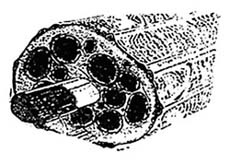
Nerve Injuries
Nerves are fragile and can be damaged by pressure, stretching, or cutting. Injury to a nerve can stop signals to and from the brain, causing muscles not to work properly, and a loss of feeling in the injured area.
AnatomyNerves are part of the "electrical wiring" system that carries messages between the brain and the rest of the body. Motor nerves carry messages between the brain and muscles to make the body move. Sensory nerves carry messages between the brain and different parts of the body to signal pain, pressure, and temperature.
 Nerve with bundles of individual nerve fibers and surrounding sheath.
A ring of tissue covers the nerve, protecting it just like the insulation surrounding an electrical cable. Nerves are composed of many fibers, called axons. These axons are separated into bundles within the nerve. The bundles are surrounded by tissue layers, just like the outer tissue layer that surrounds the nerve.
Cause
Nerve with bundles of individual nerve fibers and surrounding sheath.
A ring of tissue covers the nerve, protecting it just like the insulation surrounding an electrical cable. Nerves are composed of many fibers, called axons. These axons are separated into bundles within the nerve. The bundles are surrounded by tissue layers, just like the outer tissue layer that surrounds the nerve.
Cause
Pressure or stretching injuries can cause fibers within the nerve to break. This may interfere with the nerve's ability to send or receive signals, without damaging the cover.
When a nerve is cut, both the nerve and the insulation are severed. Sometimes, the fibers inside the nerve break while the insulation remains intact and healthy. If the insulation has not been cut, the end of the fiber farthest from the brain dies. The end that is closest to the brain does not die. After some time, it may begin to heal. New fibers may grow beneath the intact insulating tissue until it reaches a muscle or sensory receptor.
If both the nerve and insulation have been severed and the nerve is not fixed, the growing nerve fibers may form a painful nerve scar, or neuroma.
Surgical Treatment Nerve repair with realignment of bundles.
The insulation around both ends of the injured nerve is sewn together. The goal in fixing the nerve is to save the insulating cover so that new fibers can grow and the nerve can work again.
Nerve repair with realignment of bundles.
The insulation around both ends of the injured nerve is sewn together. The goal in fixing the nerve is to save the insulating cover so that new fibers can grow and the nerve can work again.
If a wound is dirty or crushed, surgery may be delayed until the skin has healed.
If there is a space between the ends of the nerve, it may be necessary to take a piece of nerve (nerve graft) from a donor part of the body to fix the injured nerve. This may cause permanent loss of feeling in the area where the donor nerve graft was taken.
Once the insulating cover of the nerve is repaired, the nerve generally begins to heal three or four weeks after the injury. Nerves usually grow one inch every month, depending on the patient's age and other factors. With an injury to a nerve in the arm above the fingertips, it may take up to a year before feeling returns to the fingertips. The feeling of pins and needles in the fingertips is common during the recovery process. While this can be uncomfortable, it usually passes and is a sign of recovery.
Recovery Several things can be done to keep up muscle activity and feeling while waiting for the nerve to heal.- Physical therapy will keep joints flexible. If the joints become stiff, they will not work, even after the muscles begin to work again.
- If a sensory nerve has been injured, care must be taken not to burn or cut fingers because there is no feeling in the affected area.
- With a nerve injury, the brain may need to be "re-educated." After the nerve has recovered, sensory re-education may be needed to improve feeling to the hand or finger. The physician will recommend appropriate physical therapy based on the nature and location of the injury.
Factors that may affect results after nerve repair include age, the type of wound and nerve, and location of the injury. Although nerve injuries may create lasting problems, proper treatment helps patients return to more normal function.
Source: http://orthoinfo.aaos.org/topic.cfm?topic=A00016
